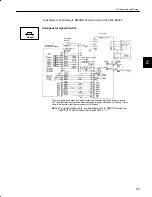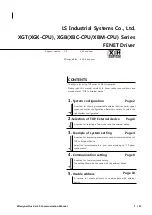
BASIC USES OF
Σ
-SERIES PRODUCTS
2.4.3 Step 2: Conducting a Test Run with the Motor Connected to the Machine cont.
44
NOTE
Before proceeding to step 2, repeat step 1 (conducting a test run for the motor without load)
until you are fully satisfied that the test has been completed successfully. Operation faults that
arise after the motor is connected to the machine not only damage the machine but may also
cause an accident resulting in injury or death. Therefore, all items including user constants
setting and wiring should be tested as conclusively as possible before step 1 is complete.
(1) Check that power is OFF.
Turn the Servopack power OFF.
(2) Connect the servomotor to the machine.
Refer to
2.2.2 Installing the Servomotor
.
(3) Perform autotuning.
Tune the Servopack according to the machine
characteristics. Refer to
4.2.3 Autotuning
.
(4) Operate by reference input.
As in step 1 (conducting a test run for motor
without load), perform (9)
Operate by refer-
ence input
on page 41. Perform tuning
associated with the host controller.
(5) Set user constants and record the settings.
Set user constants as necessary. Record all
the user constant settings for maintenance
purposes.
This is all that is required to conduct the test run.
Normally, the machine may cause much friction because of an insufficient running-in pe-
riod. After a test run is complete, perform adequate running-in.
2
Power
supply
Servopack
Power OFF
Install servomotor on machine.
Servomotor
Autotuning:
Automatically measures
machine characteristics and
performs optimum tuning
Servopack
Servomotor
DR2
Host
controller
Servopack
Servomotor
Reference
Servopack
User constants
Record the settings
















































